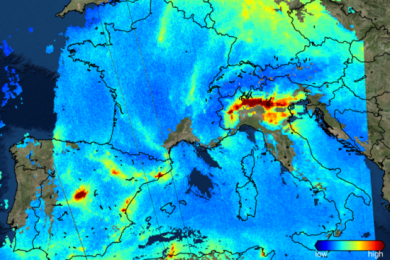Sentinel-5P is the latest satellite mission of the European Earth observation programme, Copernicus. The satellite was launched on 13 October to monitor the atmosphere and map gases and particles that pollute the air. Less than two months after its launch, the Sentinel-5P has already delivered its first images of air pollution thus marking an important milestone both for the mission and for atmospheric monitoring from space in general..
The images were presented on 1 December at the Earth Observation Center (EOC) of the German Aerospace Center (DLR) in Oberpfaffenhofen, where Sentinel-5P’s data is processed. Although the satellite is not yet ready for service, these first results show how this mission has the ability to deeply improve the task of monitoring air quality. All data provided by the Copernicus programme, including the data that will be provided by Sentinel-5P, is free and open to access.
The high resolution images of air pollutants are a result of the Tropomi (TROPOspheric Monitoring Instrument), the most advanced sensor of its type to date. Tropomi can map pollutants such as nitrogen dioxide, methane, carbon monoxide and aerosols, all of which affect the air we breathe with a number of them also playing a role in climate change. The mission is offering unprecedented detail and allows for the whole planet to be mapped every 24 hours. In addition to rapid availability, atmospheric data is invaluable, especially for long-term observation which can help us better understand and recognise change processes over time.
Among the first images recorded by Sentinel-5P there is that of the recent volcanic eruption in Bali which provides important measurements of the gases and aerosols over the Indonesian island.
Thanks to Sentinel-5P, smaller sources of pollutants can now be detected. For example, a timely Sentinel-5P evaluation shows high concentrations of nitrogen dioxide pollution over parts of the Netherlands, the Ruhr area in western Germany, the Po Valley in Italy and over parts of Spain, mainly caused by car emissions and the burning of fossil fuels in industry.

